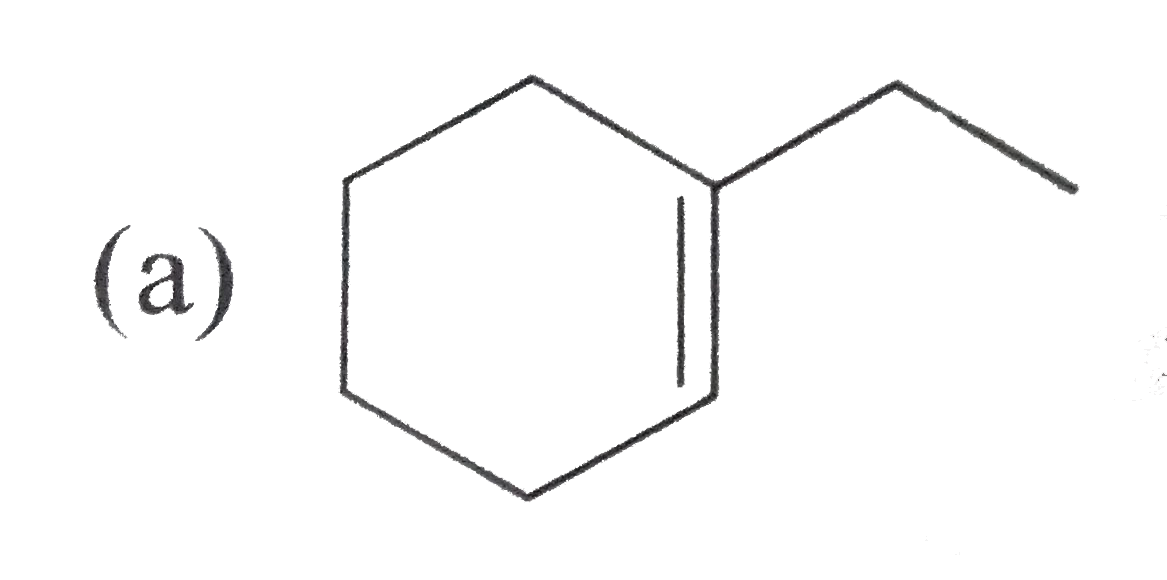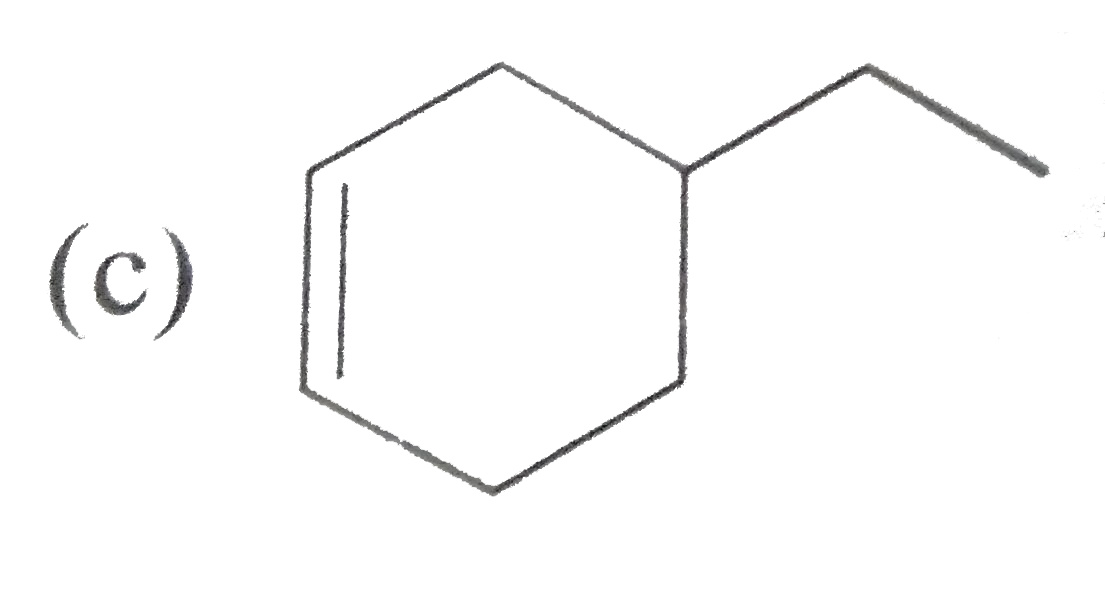Alkyne can be reduced to alkenes by hydrogenation in presence of
Ranyey Ni
Anhy. AlCl3
Pd
Lindlar's catalyst
The correct Answer is:D
To solve the question "Alkyne can be reduced to alkenes by hydrogenation in presence of," we will analyze the options provided and determine which one is suitable for the reduction of alkynes to alkenes.
1. Understanding the Reaction:
- We need to convert an alkyne (which has a triple bond) into an alkene (which has a double bond) through hydrogenation. This process involves the addition of hydrogen (H₂) across the triple bond.
2. Analyzing the Options:
- Option A: Raney Nickel:
- Raney nickel is a catalyst that can reduce alkynes to alkanes (single bonds) rather than stopping at the alkene stage. Therefore, this option is not suitable for our purpose.
- Option B: Anhydrous AlCl₃:
- Anhydrous aluminum chloride (AlCl₃) is primarily used as a Lewis acid in electrophilic aromatic substitution reactions and does not facilitate the hydrogenation of alkynes. Thus, this option is also not suitable.
- Option C: Palladium:
- Palladium is a strong catalyst for hydrogenation. However, it tends to reduce alkynes all the way to alkanes rather than stopping at alkenes. Therefore, this option does not meet our requirement.
- Option D: Lindlar's Catalyst:
- Lindlar's catalyst is a specific catalyst used for the partial hydrogenation of alkynes to alkenes. It consists of palladium deposited on calcium carbonate and is poisoned (usually with lead or sulfur) to prevent complete hydrogenation to alkanes. This makes it the correct choice for our reaction.
3. Conclusion:
- The correct answer is Lindlar's Catalyst, as it effectively reduces alkynes to alkenes without further reduction to alkanes.
Final Answer:
D: Lindlar's Catalyst
- We need to convert an alkyne (which has a triple bond) into an alkene (which has a double bond) through hydrogenation. This process involves the addition of hydrogen (H₂) across the triple bond.
- Option A: Raney Nickel:
- Raney nickel is a catalyst that can reduce alkynes to alkanes (single bonds) rather than stopping at the alkene stage. Therefore, this option is not suitable for our purpose.
- Option B: Anhydrous AlCl₃:
- Anhydrous aluminum chloride (AlCl₃) is primarily used as a Lewis acid in electrophilic aromatic substitution reactions and does not facilitate the hydrogenation of alkynes. Thus, this option is also not suitable.
- Palladium is a strong catalyst for hydrogenation. However, it tends to reduce alkynes all the way to alkanes rather than stopping at alkenes. Therefore, this option does not meet our requirement.
- Lindlar's catalyst is a specific catalyst used for the partial hydrogenation of alkynes to alkenes. It consists of palladium deposited on calcium carbonate and is poisoned (usually with lead or sulfur) to prevent complete hydrogenation to alkanes. This makes it the correct choice for our reaction.
- The correct answer is Lindlar's Catalyst, as it effectively reduces alkynes to alkenes without further reduction to alkanes.
D: Lindlar's Catalyst
Topper's Solved these Questions
- BOOK - A2ZCHAPTER - HYDROCARBONSEXERCISE - Benzene23videos
HYDROCARBONS
- BOOK - A2ZCHAPTER - HYDROCARBONSEXERCISE - Section B - Assertion Reasoning27videos
HYDROCARBONS
- BOOK - A2ZCHAPTER - HYDROCARBONSEXERCISE - Methods Of Preparation Of Alkanes31videos
HYDROCARBONS
- BOOK - A2ZCHAPTER - ENVIRONMENTAL CHEMISTRYEXERCISE - Section D - Chapter End Test30videos
ENVIRONMENTAL CHEMISTRY
- BOOK - A2ZCHAPTER - HYDROGENEXERCISE - Section D - Chapter End Test30videos
HYDROGEN
Similar Questions
Acetaldehyde can be reduced to ethane in the presence of LiAlH4.
View SolutionHydrogenation of alkenes and alkynes takes place in presence of certain catalysts. In Sabatier Senderen's reaction, the addition of hydrogen takes place I presence of Raney nickel catalyst. Platininm and palladium can also be used as catalyst and used in finley divided state. Experimentally, it is observed that less crowded alkenes adsorb H2 with faster rate. Controlled hydrogenation of alkyne H2 with faster rate. Controlled hydrogenation of alkyne in presence of Lindlar's catalyst yields cis product i.e., 'cis' alkene. Thus, in presence of Lindlar's catalyst 'syn' addition takes place. The relative rate of hydrogenation follows the order:

Non-terminal alkynes are reduced in presence of Na or Li metal dissolved in liquid ammonia. In this reaction, anti-addition of hydrogen results into the trans-product.
H3C−C≡C−CH3+H2Pd/CaCO3−−−−−−−−−→Boiling Quinoline(A)
The product (A) will be:View Solution
Knowledge Check
- Question 1 - Select One
Hydrogenation of alkyne is
AAddition reactionBElimination reactionCRearrangement reactionDSubstitution reaction - Question 2 - Select One
Hydrogenation of alkenes and alkynes takes place in presence of certain catalysts. In Sabatier Senderen's reaction, the addition of hydrogen takes place I presence of Raney nickel catalyst. Platininm and palladium can also be used as catalyst and used in finley divided state. Experimentally, it is observed that less crowded alkenes adsorb H2 with faster rate. Controlled hydrogenation of alkyne H2 with faster rate. Controlled hydrogenation of alkyne in presence of Lindlar's catalyst yields cis product i.e., 'cis' alkene. Thus, in presence of Lindlar's catalyst 'syn' addition takes place. The relative rate of hydrogenation follows the order:

Non-terminal alkynes are reduced in presence of Na or Li metal dissolved in liquid ammonia. In this reaction, anti-addition of hydrogen results into the trans-product.
Answer the following questions:
The relative rate of catalytic hydrogenation of following alkenes is:
 AII gt III gt IV gt IBI gt IV gt III gt IICIII gt IV gt I gt IIDII gt IV gt I gt III
AII gt III gt IV gt IBI gt IV gt III gt IICIII gt IV gt I gt IIDII gt IV gt I gt III - Question 3 - Select One
Hydrogenation of alkenes and alkynes takes place in presence of certain catalysts. In Sabatier Senderen's reaction, the addition of hydrogen takes place I presence of Raney nickel catalyst. Platininm and palladium can also be used as catalyst and used in finley divided state. Experimentally, it is observed that less crowded alkenes adsorb H2 with faster rate. Controlled hydrogenation of alkyne H2 with faster rate. Controlled hydrogenation of alkyne in presence of Lindlar's catalyst yields cis product i.e., 'cis' alkene. Thus, in presence of Lindlar's catalyst 'syn' addition takes place. The relative rate of hydrogenation follows the order:

Non-terminal alkynes are reduced in presence of Na or Li metal dissolved in liquid ammonia. In this reaction, anti-addition of hydrogen results into the trans-product.
In which of the following cases, the reaction is most exothermic?A B
B C
C D
D
Hydrogenation of alkenes and alkynes takes place in presence of certain catalysts. In Sabatier Senderen's reaction, the addition of hydrogen takes place I presence of Raney nickel catalyst. Platininm and palladium can also be used as catalyst and used in finley divided state. Experimentally, it is observed that less crowded alkenes adsorb H2 with faster rate. Controlled hydrogenation of alkyne H2 with faster rate. Controlled hydrogenationof alkyne in presence of Lindlar's catalyst yields cis product i.e., 'cis' alkene. Thus, in presence of Lindlar's catalyst 'syn' addition takes place. The relative rate of hydrogenation follows the order:

Non-terminal alkynes are reduced in presence of Na or Li metal dissolved in liquid ammonia. In this reaction, anti-addition of hydrogen results into the trans-product.
The product of the following reaction is:
 View Solution
View SolutionThe oxide which can be reduced by hydrogen is :
View SolutionHydrogenation of alkenes and alkynes takes place in presence of certain catalysts. In Sabatier Senderen's reaction, the addition of hydrogen takes place I presence of Raney nickel catalyst. Platininm and palladium can also be used as catalyst and used in finley divided state. Experimentally, it is observed that less crowded alkenes adsorb H2 with faster rate. Controlled hydrogenation of alkyne H2 with faster rate. Controlled hydrogenation of alkyne in presence of Lindlar's catalyst yields cis product i.e., 'cis' alkene. Thus, in presence of Lindlar's catalyst 'syn' addition takes place. The relative rate of hydrogenation follows the order:

Non-terminal alkynes are reduced in presence of Na or Li metal dissolved in liquid ammonia. In this reaction, anti-addition of hydrogen results into the trans-product.
Answer the following questions:
The relative rate of catalytic hydrogenation of following alkenes is:
 View Solution
View SolutionHydrogenation of alkenes and alkynes takes place in presence of certain catalysts. In sabatier-Senderen's reaction, the addition of hydrongen taken place in presence of nickel catalyst. Controlled hydrogenation of alkyne in presence of Lindlar's catalyst gives cis-alkene. Non terminal alkynes are reduced by Na or Li metal dissolved in liquid NH3. In this reaction trans alkenes are formed.
Q. In which of the following the reaction is most exothermicView SolutionHydrogenation of alkenes and alkynes takes place in presence of certain catalysts. In sabatier-Senderen's reaction, the addition of hydrongen taken place in presence of nickel catalyst. Controlled hydrogenation of alkyne in presence of Lindlar's catalyst gives cis-alkene. Non terminal alkynes are reduced by Na or Li metal dissolved in liquid NH3. In this reaction trans alkenes are formed.
Q. The product of the following reaction is
 View Solution
View Solution

